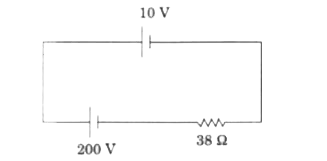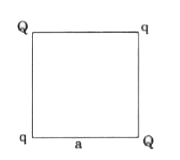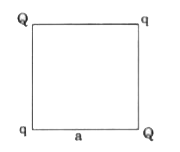Complete Solutions to SECTION B of chapter 2018 QUESTION PAPER (DELHI ) of Class 12 book with complete answers and questions
| Class 12 | PHYSICS |
| Chapter | 2018 QUESTION PAPER (DELHI ) |
| SUPPORT MATERIAL | SECTION B |
| Number Of Questions | 26 |
| Academic Year | 2023-24 |
Two elelctric bulbs P and Q have their resistance in the ratio of 1: 2. They are connected in series across a battery. Find the ratio of the power dissipation in these bulbs.
01:23View SolutionA 10 V cells of negligible internal resistance is connected in parallel across a battery of emf 200 V and internal resistance 38Q . As shown in the figures , Find the value of current in the circuit

In a potentiometer arrangement for determining the emf . of a cell the balance point of the cell in open circuit is 350 cm. When a resistance of 9Q . is used in the external circuit of the cells the balance point shift to 300 cm. Determine the internal resistance of the cell.View Solution(a) Why are infrared waves often called heat waves? Explain.
(b) What do you understand by the statement, "Electromagnetic waves transport momentum"?04:00View Solution(a) Why are infrared waves often called heat waves? Explain.
(b) What do you understand by the statement, "Electromagnetic waves transport momentum"?04:00View SolutionIf light of wavelength `412.5` nm is incident on each of the metals given below, which one will show photoelectric emission and why ?
02:32View SolutionA carrier wave of peak voltage 15 V is used to transmit a message signal. Find the peak voltage of the modulating signal in order to have a modulation index of 60%.
01:51View SolutionFour point charges Q.q Q and q are placed at the corners of a square side 'a' as shown in the figures.

Find the resultant electric force on a charge Q,10:03View SolutionFour point charges Q.q Q and q are placed at the corners of a square side 'a' as shown in the figures.

Find the Potential energy of this system.06:28View Solution(a) Three point charges q,-4q and 2q are placed at the vertices of an equilateral triangle ABC of side 'l' as shown in the figure. Obtain the expression for the magnitude of the resultant electric force acting on the charge q.
(b) Find out the amount of the work done to separate the charges at infinite distance.
 08:14View Solution
08:14View SolutionFind out the amount of the work done to separate the charges at infinite distance.
01:53View SolutionDefine the term electrical conductivity of a metallic wire. Write its SI unit.
02:06View SolutionUsing the concept of free electrons in a conductior , derive the expression for the conductivity of a wire in terms of number density and relaxation time . Hence obtain the relation between current density and the applied electric field E.
View SolutionA bar magnet of magnetic moment 6 `J//T` is aligned at `60^(@)` with a uniform external magnetic field of 0.44 T. Calculate (a) the work done in turning the magnet to align its magnetic moment (i) normal to the magnetic field, (ii) opposite to the magnetic field, and (b) the torque on the magnet in the final orientation in case (ii).
02:57View SolutionThe torque on the magnet in the final orientation
View Solution(a) An iron ring of relative permeability `mu_(r)` has windings of insulated copper wire of n turns per metre. When the current in the windings is I, find the expression for the magnetic field in the ring.
(b) The susceptibility of a magnetic material is 0.9853. Identify the type of magnetic material. Draw the modification of the field pattern on keeping a piece of this material in a uniform magnetic field.04:58View SolutionThe susceptibility of a magnetic material is `0.9853` Identify the type of magnetic material .Draw the modification of the field pattern on keeping a piece of this material in a uniform magnetic field.
View SolutionShow using a proper diagram how unpolarised light can be linearly polarised by reflection from a transparent glass surface.
View Solution(a) Show using a proper diagram how unpolarised light can be linearly polarised by reflection from a transparent glass surface.
(b) The figure shows a ray of light falling normally on. the face AB of an equilateral glass prism having refractive index 3/2, placed A in water of refractive index 4/3. Will this ray suffer total internal reflection on striking the face AC? Justify your answer.05:30View Solution(a) If one of two identical slits producing interference in Young's experiment is covered with glass so that the light intensity passing through it is reduced to 50%, find the ratio of the maximu and minimum intensity of the fringe in the interference pattern.
(b) What kind of fringes do you expect to observe if white light is used instead of monochromatic light ?04:20View Solution(a) If one of two identical slits producing interference in Young's experiment is covered with glass so that the light intensity passing through it is reduced to 50%, find the ratio of the maximu and minimum intensity of the fringe in the interference pattern.
(b) What kind of fringes do you expect to observe if white light is used instead of monochromatic light ?04:20View SolutionA symmetric biconvex lens of radius of curvature R and made of glass of refractive index 1.5, is placed on a layer of liquid placed on top of a plane mirror as shown in the figure. An optical needle with its tip on the principal axis of the lens is moved along the axis until its real, inverted image coincides with the needle itself. The distance of the needle from the lens is measured to be x. On removing the liquid layer and repeating the experiment, the distance is found to be y. Obtain the expression for the refractive index of the liquid in terms of x and y.
 15:54View Solution
15:54View Solution(a) State Bohr's postulate to define stable orbits in hydrogen atom. How does de Broglie's hypothesis explain the stability of these orbits ?
(b) A hydrogen atom initially in the ground state absorbs a photon which excites it to then n = 4 level . Estimate the frequeny of the photon.05:11View Solution(a) State Bohr's postulate to define stable orbits in hydrogen atom. How does de Broglie's hypothesis explain the stability of these orbits ?
(b) A hydrogen atom initially in the ground state absorbs a photon which excites it to then n = 4 level . Estimate the frequeny of the photon.05:11View Solution(a) Explain the processes of nuclear fission and nuclear fusion by using the plot of binding energy per nucleon (BE/A) versus the mass number A.
(b) A radioactive isotope has a hald -life of 10 years. How long will it take for the activity to reduce to 3.125%.11:26View SolutionA radioactive isotope has a half-life of 10 year.How long will it take for the activity to reduce to 3-125% ?
View Solution(a) A student wants to use tow p-n junction diodes to convert alternating current in to direct curent draw the labelled circuit diagram she would use and explain how it works
(b) give the truth table and circuit symbol for NAND gate04:47View Solution
SECTION B questions and complete solutions for chapter 2018 QUESTION PAPER (DELHI ) of CBSE COMPLEMENTARY MATERIAL PHYSICS (HINGLISH) of Class 12
